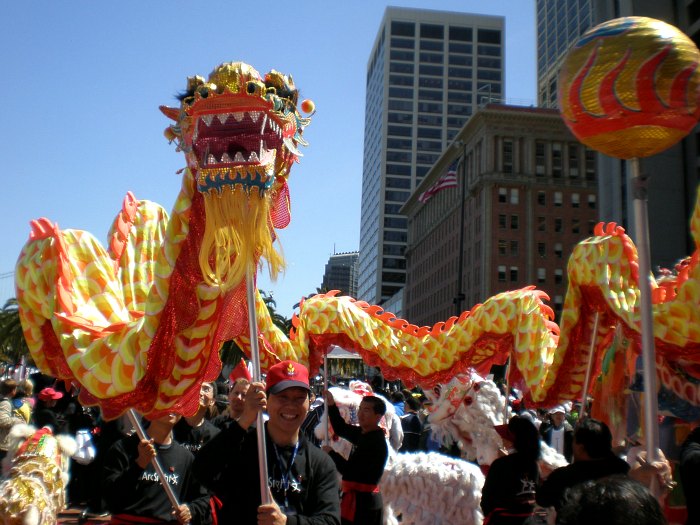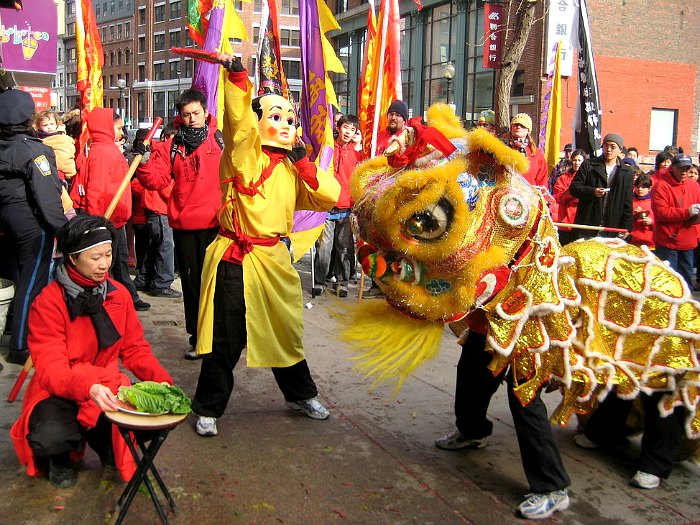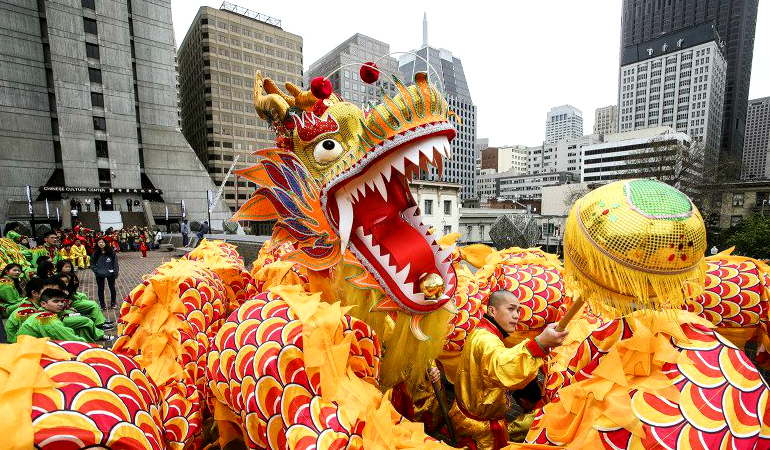This article is part of our Chinese New Year Family Guide. Sign up for our newsletter to receive family-friendly activity, recipe and craft ideas throughout the year!
Though traditional dragon and lion dances are indispensable parts of community celebrations during Chinese New Year, it’s easy to get the two confused. In this guide, I’ll describe what to watch for and how to tell them apart at your next Chinese New Year festival or parade.

Dragons are a powerful symbol of imperial China believed to bring good luck to the country’s people. During Chinese New Year, it’s thought that the longer the dragon, the more luck (and, historically, the more rain for the upcoming harvest season) will be brought to the community.
To spot the dragon dance, watch for a large team of dancers who maneuver a long, serpentine body held aloft on poles with a dragon head and tail at either end. The dance team undulates the dragon’s body in time with the sounds of horns, drums and cymbals.
Many dancers are needed to control the dragon’s long body, which can extend to 30 yards in length. The dragon’s body is made from thin bamboo strips covered in cloth and painted with scales.
Dancing dragons are frequently led by someone holding a large sphere. It’s usually either a white pearl representing the pursuit of wisdom or a red sun representing the hope for a good harvest in the season ahead.
Here’s a great example of a traditional dragon dance on YouTube.

It’s enough that lions are generally regarded as auspicious animals. However, the lion dance’s inclusion at Chinese New Year traces to the desire to chase away the evil spirit, Nian, who feared only lions and the color red.
To spot the lion dance, watch for a small team of two dancers who mimic the animal’s various movements from inside an ornate lion costume. Most lion dancers are highly trained and follow carefully choreographed routines based on the martial arts.
During Chinese New Year, you may notice the sounds of drums and firecrackers as lion dancers “pluck the greens” to bring good fortune to local shops. In this custom, lion dancers root through lettuce and other green vegetables placed in front of businesses searching for their reward, a red envelope with money inside.
It’s fun to watch for the subtle differences between lion dances performed in the north and south of China. Northern lion dances favor active movements like rolling, wrestling and jumping, while southern lion dances emphasize behavioral movements like scratching, fur licking and eating.
Here’s a great example of a traditional lion dance on YouTube.
Though you may see dragon and lion dances performed at other celebrations throughout the year, it’s most exciting when they appear bobbing and weaving their way through Chinese New Year parades around the world.
Your turn! What your favorite dragon or lion dance memory? Have you been on a dance team yourself? I’d love to hear from you in the comments section below!
HT: Photos by San Francisco Examiner, Wikimedia Commons – Lion Dance and Wikimedia Commons – Dragon Dance.





Sandie
The dragon and lion was so real in my life. My parents made it “real” for my childhood. It was not until I was a young adult that I figured it out. The iconic figure is on our Chinese ceramics, dish wares, home decors, clothing, etc. I never battled the idea it wasn’t real. Being a “too gee”(American born Chinese), I praise you for your well-written articles.
Before I retired as a teacher, I did the Chinese New Year unit in my classroom so the children would see what the hype was all about. I would bring in the lion head, red envelopes, oranges, and I would demonstrate to my primary grade children. We would compare and contrast to other cultural groups. Thank you for all your resources.
Wes Radez
Sandie, thanks for sharing your story! I’m so glad to hear about your efforts to share the culture among your students. ~Wes